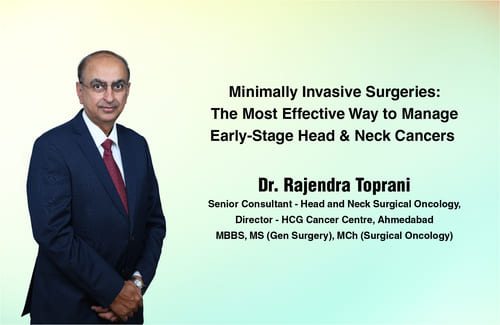What is Papillary Thyroid Carcinoma (PTC)?
Papillary thyroid carcinoma is a common type of thyroid cancer, and it is associated with radiation exposure. Papillary thyroid carcinoma grows slowly, generally spreads to lymph nodes, and is less likely to spread to blood vessels.
Is Papillary Thyroid Cancer Serious?
During the initial presentation, almost 10% of the patients have been observed to have metastatic papillary thyroid carcinoma. The American Cancer Society reports that the treatment is generally successful, and the cancer rarely results in death. Most patients, especially those below the age of 45, have a good prognosis.
Variants of Papillary Thyroid Carcinoma
The variants of papillary thyroid carcinoma include:
-
Classic variant papillary thyroid carcinoma:
This variant of papillary cancer of the thyroid is characterized by true papillae, which is indicated by the papillae with the vascular core at the center.
-
Infiltrative follicular variant papillary thyroid carcinoma:
Follicular variant of papillary thyroid carcinoma is a common subtype of PTC. This variant’s clinical behaviors are unique and intermediate between classical PTC and follicular thyroid cancer.
-
Tall cell variant papillary thyroid carcinoma
: It accounts for 1.3 to 13% of the total PTC cases. The height-width ratio of 3:1 indicates the tall cells. This variant has a low survival rate and a high recurrence risk.
-
Hobnail variant papillary thyroid carcinoma:
This variant is characterized by hobnail cells (hobnail areas >30%). It has been reported that the prognosis of this variant is worse than the classical variant.
- Solid/trabecular variant papillary thyroid carcinoma: It is a rare variant of PTC (3% of all PTC cases) and has a poorer prognosis than the classical subtype. It is characterized by the presence of an almost solid tumor.
-
Oncocytic variant papillary thyroid carcinoma:
It is a rare type of PTC and has nuclear features of papillary carcinoma and oncocytic cytoplasm.
-
Columnar variant papillary thyroid carcinoma:
It is a rare subtype of PTC and accounts for about 0.5% to 2% of all PTC cases. It is an aggressive subtype with a fast growth rate and high recurrence risk.
-
Diffuse sclerosing variant papillary thyroid carcinoma:
It accounts for about 6% of all cases of PTC. The studies reported that although it is an aggressive cancer, the prognosis is similar to that of the classic PTC.
What are the Stages of Papillary Thyroid Carcinoma (PTC)?
The stages of PTC are divided based on the age of patients.
For people under the age of 55 years
- Stage 1: The patients have a tumor of any size, and it may not have spread to lymph nodes or other body parts.
- Stage 2: The patients have a tumor of any size, and it may have invaded lymph nodes and/or other body parts.
For people over the age of 55 years
- Stage 1: Cancer is limited to the thyroid and is ≤4 cm.
- Stage 2: Cancer is in the thyroid and nearby lymph nodes and measures ≤4 cm OR cancer is in the thyroid, measures >4 cm, and may or may not spread to nearby lymph nodes OR tumor of any size, spread to nearby neck muscles, and may or may not spread to nearby lymph nodes.
- Stage 3: Tumor of any size that has spread to soft tissues below the skin, windpipe, esophagus, laryngeal nerve, or larynx and may or may not spread to lymph nodes.
- Stage 4A: The tumor is of any size and has spread to the front of the pine. It may or may not surround the carotid artery and blood vessels between the lungs and may or may not spread to lymph nodes.
- Stage 4B: The tumor can be of any size, and it has spread to bones, lungs, and lymph nodes.
- Recurrent: At times, thyroid cancer may recur sometime after the treatment, and may need more comprehensive treatment approaches and follow-up protocols to be managed effectively.
What are the Risk Factors for Papillary Thyroid Cancer?
Certain factors increase the risk of PTC. These are:
-
Gender and Age:
Papillary thyroid cancer is more common in women, especially in those below the age of 40 years. The reasons for this are not known.
-
Genetics:
Certain genetic conditions, such as familial adenomatous polyposis, Werner syndrome, Gardner syndrome, and Carney complex type 1, increase the risk of PTC.
-
Radiation Exposure:
People with a history of significant exposure to ionizing radiation have an increased risk for PTC.
-
Dietary Iodine Content
: A higher incidence of PTC has been reported in regions with a high dietary iodine intake.
Papillary Thyroid Cancer Symptoms
Papillary thyroid carcinoma symptoms include:
-
Breathing difficulties
-
Cervical lymph node enlargement
-
Changes in voice/hoarseness
-
Difficulty swallowing
-
Lump in the neck
-
Neck enlargement
-
Neck pain or discomfort
-
Thyroid nodule
Cause of Papillary Thyroid Cancer
Some of the papillary thyroid cancer causes are:
-
Certain genetic conditions:
Some people with PTC also have underlying genetic conditions, such as familial adenomatous polyposis— Werner syndrome, Gardner syndrome, and Carney complex type 1.
-
Family history:
Family history of PTC and patients with a medical history of benign thyroid diseases may have PTC.
-
Radiation therapy:
Radiation therapy is also the cause of PTC. High-dose radiation (>2000 cGy) therapy for managing malignant conditions may cause PTC.
-
Gender:
There is a higher incidence of PTC in women than men.
How to Diagnose Papillary Thyroid Carcinoma?
-
Physical exam:
Oncologists may perform a comprehensive physical examination to determine the cause of symptoms experienced by the patients. It includes evaluating the neck for lump, determining the presence and severity of hoarseness, and finding the difficulty of swallowing. If there is a suspicion about the presence of a tumor, patients are advised to undergo further tests.
- Thyroid-stimulating Hormone (TSH): Higher-than-normal levels of thyroid-stimulating hormone may be associated with PTC. However, higher TSH levels indicate other thyroid conditions, too.
- T3 and T4 (Thyroid Hormones): Patients with PTC may have higher levels of thyroid hormones. However, blood tests are not specific to PTC.
- Thyroglobulin: Higher thyroglobulin levels may also indicate disease of the thyroid.
-
Imaging Tests
- Ultrasound: Through ultrasound, the oncologists examine the overall structure of the thyroid gland and the tumor nodules. It may also be detected if the cancer has spread to nearby lymph nodes.
- Computed Tomography (CT) Scan: It is also used for diagnosing and staging PTC. CT scan also evaluates the location and size of thyroid tumors.
- Magnetic Resonance Imaging (MRI) Scan: MRI also assists oncologists in diagnosing PTC. The sensitivity of MRI for PTC is higher than CT scan. However, the overall sensitivity of MRI is low (67%).
- Positron Emission Tomography (PET)/CT Scan: Although PET/CT scan has low sensitivity for PTC, but is useful in diagnosing PTC in patients with elevated serum thyroglobulin or anti-thyroglobulin antibody and negative diagnostic radioiodine scan.
-
Biopsy:
Fine needle aspiration may also be advised by oncologists to confirm the presence of PTC. Calcified nodules with multiple blood vessels and no clear borders may indicate PTC. The oncologists recommend the biopsy for any nodule >1 cm in size.
Papillary Thyroid Carcinoma Treatment Options
Some of the papillary thyroid carcinoma treatment options are:
- Surgery: Surgery involves the removal of the cancerous tissue along with a small portion of healthy tissues. Thyroid cancer can be treated with both open surgery and minimally invasive surgery. Depending on the stage of the disease, the following surgical procedures may be recommended:
- Removing all or most of the thyroid (thyroidectomy): In this surgery, the onco-surgeons remove either all or most of the thyroid gland, depending upon the extent of tumor spread.
- Removing a portion of the thyroid gland (thyroid lobectomy): Two thyroid lobes are in the thyroid gland. Removing the affected thyroid lobe is known as thyroid lobectomy.
- Removing lymph nodes (lymph node dissection): If cancer has spread to nearby lymph nodes, the onco-surgeons may also remove the affected lymph nodes, along with the thyroid gland.
Papillary thyroid cancer surgery side effects include infection, damage to the laryngeal nerve, or accidental removal of the parathyroid gland.
-
Radioactive iodine:
Certain PTC cells absorb iodine. The oncologists may prescribe radioactive iodine therapy. The radioactive iodine is absorbed by the cancer cells resulting in their destruction.
- Radiation therapy: Radiation therapy may be an option for papillary thyroid cancer treatment after surgery. It involves the use of either external or internal high-energy radiation to kill cancer cells. An external radiation source is a machine, while radioactive seeds are placed in or near the cancer cells to kill them.
-
Chemotherapy:
Chemotherapy is also an option for papillary carcinoma treatment. The drugs may be delivered orally or directly into the blood through injection. However, chemotherapy is not a usual treatment option for PTC, and few people require chemotherapy to manage PTC.
-
Thyroid hormone therapy:
Thyroid hormone therapy functions through two mechanisms. One, it administers thyroid hormone to the body, which is not produced after thyroidectomy. Second, it reduces the level of thyroid stimulating hormone that may assist the growth of remaining papillary thyroid cancer cells.
-
Targeted therapy:
It may also be used to manage PTC. In this therapy, the drug targets the processes or substances (enzymes) vital for cancer cells’ survival. Targeted therapy may also be used in cases of metastatic papillary thyroid carcinoma.
Complications of Papillary Thyroid Carcinoma
Some of the complications of papillary thyroid carcinoma are:
-
Extrathyroidal extension:
It occurs in almost 8% to 32% of patients with PTC.
-
Recurrence:
Certain variants of PTC, such as the tall cell and columnar variants, have a high risk of cancer recurrence.
-
Dysphagia:
PTC may result in swallowing difficulties if not diagnosed and treated early.
-
Dyspnea:
Complications of PTC also include trouble breathing due to excessive tumor growth in the esophagus or windpipe.
Why Choose HCG Cancer Center Ahmedabad for Papillary Thyroid Carcinoma Treatment?
HCG Cancer Center, Ahmedabad, is one of the most advanced centers for diagnosing, treating, and monitoring papillary thyroid carcinoma. The center is equipped with sophisticated and state-of-the-art diagnostic machines to detect carcinomas, such as CT scans, MRIs, and ultrasounds. Further, hormonal testing facilities are available at the center to diagnose and monitor hormonal alterations. The doctors and the staff at the center are extensively experienced and trained to treat and manage papillary thyroid cancer symptoms.
Conclusion
Papillary thyroid cancer is a common thyroid cancer. Papillary thyroid carcinoma symptoms include a lump in the neck, neck pain, difficulty breathing and swallowing, and hoarseness. Diagnosis involves physical examination, blood tests, imaging techniques, and biopsy. The papillary thyroid carcinoma treatment includes surgery, radioactive iodine therapy, radiation therapy, chemotherapy, and targeted therapy. The overall prognosis of PTC is favorable.
Frequently Asked Questions
- Is papillary carcinoma rare?
Papillary thyroid carcinoma is a common type of thyroid cancer and accounts for about 80% to 85% of all thyroid cancers.
- Why is the size of the tumor important for papillary thyroid carcinoma?
The tumor size determines the type of method used for diagnosis (biopsy is used for >1 cm nodule), staging of the disease, and treatment options.
- Where does papillary thyroid cancer spread first?
PTC generally spreads to nearby lymph nodes, bones, and lungs during the initial phase of metastasis.
- What are the early warning signs of thyroid cancer?
Early warning signs of thyroid cancer include a lump in the neck, swollen lymph nodes, sore throat, and difficulty swallowing.
- Are papillary tumors always cancerous?
No, papillary tumors are not always cancerous. Sometimes, they are benign.


